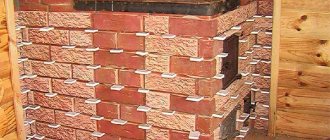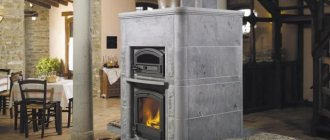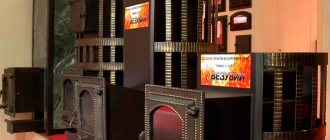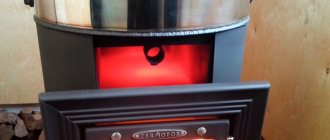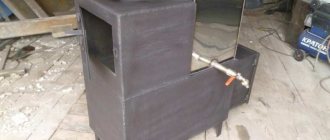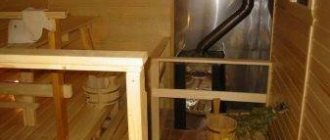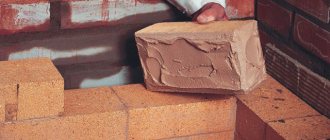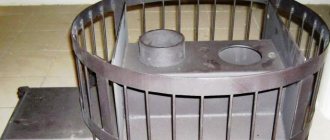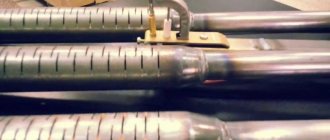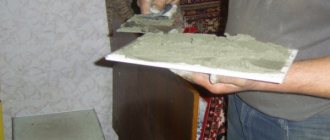Homemade sauna stoves are devices for heating air, steam, water for bath procedures, made independently. Basically, most of these devices are made of metal or brick. Next, we will understand the variety of technologies used to assemble sauna stoves in order to choose the appropriate option for each home in terms of size and materials used.
What homemade stoves for a bath can be like Source vbanepar.ru
Advantages and disadvantages of homemade sauna stoves
Most often, a metal or brick stove is chosen for a bathhouse, and in order to make the right choice, their advantages and disadvantages are taken into account.
Among the “advantages” of metal sauna stoves, it is worth highlighting the following:
- quick heating of the steam room (stone or brick gives off less heat than metal: a couple of hours after the start of kindling, and sometimes even earlier, you can go steam);
- compact design (this allows you to get more space in the main bath room);
- durability (subject to high-quality assembly, the stove will last from five to fifteen years);
- ease of use (compact metal stoves can be transported from one place to another);
- ease of manufacture (unlike, for example, the brick version);
- profitability (materials for the production of baths are inexpensive).
The advantages of a brick kiln include:
- soft steam, which is typical for spacious brick ovens;
- long-term preservation of steam and heat;
Soft steam from a brick stove Source wikimedia.org
- ease of use (there is no need to take fire protection measures before operating such a stove);
- aesthetic appeal (a brick stove looks very presentable, unlike its metal counterparts);
- ease of construction.
A simple stove for a sauna Source neoenerg.ru
However, for both types of homemade sauna stoves, the following negative points must be taken into account:
| Metal | Brick |
| Rapid cooling, which forces you to regularly add solid fuel | Heavy weight |
| The stove walls heat up too much, which reduces fire safety | Lack of mobility (all brick stoves are stationary) |
| In most cases, only suitable for small bath spaces | It is necessary to build a foundation for the furnace |
| Limited number of forms and modifications | The need to allocate a fairly large space in the bathhouse for installing a brick stove |
| Possibility of deformation from strong heat | Need to spend more money on buying building materials |
| Too dry air | Even one mistake in the brickwork can make the stove of poor quality (it will not hold high temperatures well) |
| Emission of infrared radiation | Low preparation speed for steaming (all preparatory work can be completed within an hour, and then it will take up to five to six hours for kindling). |
| Uneven distribution of heated air | — |
| The chimney needs to be cleaned constantly | — |
The chimney of a metal stove needs to be constantly cleaned Source kamin.lutsk.ua
What stones are best for a Russian bath?
To extract good quality steam, you need to choose the right stones to put in the stove and place them correctly (start with large ones and end with small ones). To perform the function of providing steam for a bath for a long time, the stones must have the following characteristics:
- maximum thermal conductivity;
- homogeneity;
- strength;
- heat capacity.
The oval and round shape of the cobblestones, even when laid randomly, will ensure guaranteed air spaces between them, and, therefore, the circulation of air and moisture in the bathhouse.
Smooth cobblestones are used in saunas, while a porous structure is more suitable for wet steam rooms and Russian baths. The best stones are made from jadeite, diabase, dunite, porphyrite and basalt.
The use of granite and marble rocks for baths is not recommended. The minimum size is five centimeters, the maximum is 12 cm.
Features, types of metal and brick stoves
Simple in shape, metal sauna stoves may differ slightly in design. The classic, easiest to make option is the potbelly stove. Essentially it is a metal box with a door and a pipe. However, this form is considered uneconomical: fuel consumption is high and heat transfer is low. The thickness of the metal for a modern, more economical type of sauna stove should not be too large, the optimal one is 4-5 mm.
Some owners make a combined stove for their bathhouse, the core of which consists of metal sheets, and the outside of the structure is lined with bricks. Thus, they achieve a reduction in fire hazard and an improvement in the uniformity of heating of the surrounding air. The basis for installing such a furnace can be a concrete slab lined with ceramic tiles, refractory bricks or a metal sheet.
Among the small variety of types of metal sauna stoves, three main types stand out: closed, open and combined stoves. The first type is distinguished by a completely closed combustion zone and small size. Open stoves contain in their design places for laying out heating stones that do not close.
Closed oven Source tildacdn.com
Typically, the firebox of a homemade iron stove for a bath is placed in the waiting room, and the part with heating stones is located directly in the steam room. To properly operate an open stove, it is necessary to ensure maximum contact of stones with the outer surface of the firebox.
As for combination stoves, they have the additional ability to heat the air in the room. This can be done by equipping the structure with a network of pipes, which are attached to the stove through a pipe and are then brought out so that they cover the entire perimeter of the bathhouse complex. When the fuel in the stove burns, the energy generated heats the air, after which it begins to circulate through the pipe system. In this case, the supply of heated air is carried out by moving a special grille in the form of a valve.
Brick stoves themselves are safer than metal stoves, and also more convenient. The reason lies in the gradual and uniform heating of the air surrounding the stove. The location for the construction of such a stove must be chosen carefully. The heating element should be located near the wall of the room, but no closer than twenty centimeters from it.
Brick oven Source wmpics.pics
See also: Catalog of companies that specialize in the design and installation of fireplaces and stoves
What we need - tools and materials
Before you start making your own sauna stove from a 530 pipe, you should prepare a place to work and stock up on the necessary tools:
- welding machine;
- grinder with different attachments;
- electric drill;
- metalworking tools;
- door handles;
- mortise tap;
- asbestos cord.
In addition to tools, you will need the following material:
- Thick-walled metal pipes for fireboxes and water tanks, having a diameter of 500 to 650, a wall thickness of 8-16 mm, and a length of 1.2 to 1.5 meters. Also the pipe through which carbon monoxide will escape, its diameter is 120 - 150, and the wall thickness is 2 - 4 mm.
- A steel pipe where the stones will be placed. The thickness of its walls is 5-8 mm, and the diameter is 350.
- Sheet metal, size 600 by 800 mm, having a thickness of 8 - 12.
- Hinged steel hinges.
- Water pipe - a small piece, suitable diameter ½ or ¾ inch, length 50 - 80 mm, and a ball valve with a similar thread.
- Metal reinforcing bars - 500 mm, diameter 12 - 18.
- Cement.
- Brick.
- Sand.
How metal sauna stoves are made
To make a homemade metal sauna stove, you will need:
- five- to eight-millimeter steel sheet (several pieces will be needed, and the size and quantity will depend on the dimensions of the firebox of the stove being manufactured);
- water tap;
- ruler or tape measure;
- Bulgarian;
- a thin metal pipe with a thickness of 5 mm to 10 mm and a length of about two meters;
- grate;
- metal scissors;
- hinges and latches (depend on the number and shape of stove doors);
- four metal squares with a side length of 10 mm, or doors for three functional compartments of the stove: for the firebox, heater and blower;
- welding machine.
First of all, the firebox is made. To do this, nine square pieces of metal measuring 50 × 50 cm are measured on a metal sheet and a box is welded from them. There should be another one inside (a separating plate), while the upper part of the firebox is needed to burn fuel, and the lower part is needed to collect ash and ash. In each of these parts, holes for the doors are cut so that they are located on top of each other. After attaching the doors, proceed to the next stage.
One of the options for a stove for a bath (drawing) Source vbanepar.ru
Next, two pieces are cut from a two-meter pipe: one for the firebox (90 cm), the second for the tank (60 cm), and the first of them is welded to the firebox. After this, make a rectangular hole in a larger section of the pipe with dimensions of 20 × 50 cm for the blower and securely attach the door to it. A grate (grid) is welded onto the resulting product.
Remember! To heat a room of 14 m², it is enough to have a heater with dimensions of 30 × 40 × 30 cm.
To make a heater (that part of the stove that will contain heated stones), they take several more pieces of the plate and make a container out of them, then thick iron rods (thickness - at least ten millimeters) are welded on top of the prepared firebox. Be sure to make a hole for the door and carefully weld it onto the hinges. It is worth paying attention to the fact that the structure must be strong, because these rods or metal plates need to hold a fairly large weight of stones.
Important! To fill the heater, they usually take diabase or soapstone, but refuse to use granite (it crumbles after strong heating) and stones containing mica (it helps release carbon dioxide) or the inclusion of silicon.
A heater on a stove, welded from rods Source hozsektor.ru
Another important structural element of a homemade stove is a water tank. Above the manufactured heater, first of all, another metal plate (thickness - at least 8 mm) with a pre-made hole for the chimney is welded. After this, the pipe prepared for the smoke exit is also carefully welded to the edges of the round hole.
At the final stage, they do one more thing - in the area of the rear wall of the structure, and attach a water tap. A pipe for the tank is then welded to it. It is important to make the water tank small so that you can easily weld it on top of the stove, above the heater or next to it.
In the resulting product, after welding all the structural parts together, each node will perform its functions. So, at the very bottom (above the ash container), that is, in the firebox, fuel (for example, harvested firewood) is burned, then the heat moves through the stove to the stone section, strongly heating the stones. In this case, these stone blocks can be changed or added through the door in the heater (if it is a closed type), and the smoke comes out through the chimney.
One of the options for placing a water tank and heater on a sauna stove Source baniwood.ru
The water tank is equipped with an additional lid or other auxiliary parts that will allow you to periodically fill the container with new cold liquid. Thus, they create the simplest homemade iron sauna stove with a water tank and a heater.
Metal for sauna stove
As for the metal from which a homemade stove is made, cast iron material is usually chosen, because it is much more difficult to fasten (if there are no difficulties with fastenings, cast iron is well suited for the firebox door).
Iron plates are used, but they must take into account that when such a stove operates, the temperature in the combustion chamber rises to four hundred and fifty degrees Celsius. Thin metal under such loads begins to deform and burn through. When choosing a stainless metal with a sheet thickness of 10 mm or more, you can avoid this problem, but another one will appear - the warm-up time will increase significantly, and with it, fuel consumption.
Structural steel for furnace Source steelsukraine.com.ua
If a non-professional nevertheless decides to make a stove with his own hands, be sure to take into account the advice of experts who recommend using stainless high-alloy steel grade 08x17T. It is practically not subject to corrosion and destruction by high temperatures. An example of a product that is made of just such steel is AISI 430. It will not change its shape even when heated to a temperature of + 850 °C.
The furnace compartment, called the firebox, is exposed to the highest temperature and is in direct contact with the flame. That is why steel grade 10 is chosen for this structural part (manufactured according to the GOST 1050-88 standard); for convection parts, 08PS or 08YU is suitable (manufactured according to the rules of GOST 19904-90). Structural sheet steel is considered ideal for the body of a sauna stove.
Construction of metal furnaces
Metal is a more malleable material than ceramics; it can be melted and cast, drilled, cut, bent, and forged. There is a considerable amount of metal processing. Basically, when making a stove with your own hands from metal, you need to focus on its quality. The metals used for the production of the heating mechanism are: ordinary steel, heat-resistant variations of steel, surrogates and cast iron.
The second step will be to create a stove and choose the type of its design. The dressing comes in different forms, the main thing is to follow the joining technology. For this, there are diagrams where the structural properties of all elements are depicted in detail. It can be created with an open or covered heater. Carefully take into account the dimensions of the bath itself. The elementary design should consist of a water tank and a firebox, and definitely have a tube, a rod and a grate.
It should also have strong latches. To remove the results of combustion, it is advisable that the stove be equipped with a chimney pipe. And also a tap that will be mounted on a water tank. Not all stoves look harmonious in the interior of the house; this problem can be solved by removing the portal for the sauna stove with your own hands.
Differences between metal stoves for baths and saunas
Steam rooms in a sauna and a bathhouse have impressive differences, these are the temperature and dryness of the air. In the bathhouse, the temperature varies from 50 to 70 degrees, resulting in the formation of soft steam. The temperature in the sauna is above 85 degrees Celsius, the steam comes out dry. To create certain conditions in the steam room, different stoves and various approaches to their installation are used.
To build a sauna, it is necessary to maintain maximum contact between the stove shell and air in order to ensure rapid circulation of air flows along the walls.
It all comes down to heating the air faster. In the bathhouse, the microclimate is organized in a different way, where a high temperature is reached and a lot of steam is generated. To achieve the effects, stones are placed in a firebox, that is, in a closed heater. A small heater is placed above the firebox, which helps heat the stones to 250 degrees Celsius.
The next difference is that metal sauna stoves are convection, and all baths are organized in such a way as to avoid thermal convection without any trace. Convection in the usual syllable is the movement of air inside a room.
Do-it-yourself stoves for Russian baths
The current Russian bathhouse is a small house made of timber or logs. Inside, as a rule, there is a division into 2 rooms, namely a dressing room and a steam room. A stove for a Russian bath is not just a heating mechanism, it is its most important accessory. The temperature, dryness and heating level of the steam room depend on it. There are many categories of sauna stoves.
But not everyone is suitable for a Russian bath. The fundamental difference will be warming the air to a temperature of 65 degrees Celsius, while creating steam between 60 and 80 percent. As a result, so-called weak steam is formed in the steam room.
This is a pleasant, moderately or almost non-burning velvety steam. In a true Russian bath you can breathe nicely and simply, and your skin will not experience severe thermal stress.
Often a brick or steel stove is installed in a bathhouse. All these materials heat up well and transfer heat well to the room. There are no stamps for the construction of stoves; only the general principles of architecture and construction are observed.
Brief description and dimensions of the metal stove
An iron sauna stove can effectively heat small rooms. It is created by a covered, open and combined design. The mechanism has a tank for heating water and a heater built into the upper part of the stove. The closed device consists of 3 compartments, this is a chamber with a blower, a heater and a hole for steam outlet, and a tank for heating water.
An open-type installation has a metal grate on which stones are placed, which is located above the combustion chamber. There are no barriers between the firebox and the stones. Combined devices of this group are distinguished from others by the presence of an enlarged combustion chamber, equipped with double bolts and grates.
Fire from all edges heats the heater, and this significantly increases the productivity of the stove. The volume of the oven varies; during its construction, the parameters of the steam room and the number of people washing in it are taken into account.
The size of the heating system depends on the strength of the heating system. The higher the coefficient, the more fuel needs to be burned. For ideal air heating, the parameters of a sauna stove must be as follows: the ratio of the size of the firebox to the area of the heated room is 1:50 or 1:70, the depth of the firebox opening is 1:2 or 2:3, and the volume of the firebox to the cross-section of the chimney should be in proportion 1: 10.
A heat exchanger for a sauna stove is a technical unit that heats the incoming liquid and then transfers it to a hanging container.
Design features of a metal furnace firebox
The furnace firebox is the most important element of any hearth. It sets the characteristics of the furnace, since the heating speed and the quality of the steam produced depend on it. A firebox or firebox is a device for burning organic fuel. Fireboxes are made from different materials, are designed for different types of fuel, and have different sizes.
A metal or ready-made furnace firebox is a high-tech device that is more economical in fuel consumption. Its efficiency depends on proper design.
The classic firebox for sauna stoves consists of the following basic elements:
- front is the front part of the combustion space where the loading door is located;
- the head wall, where, depending on the furnace mechanism, an outlet window for removing flue gases may be located;
- the arch of the firebox or ceiling where the exit window is located;
- sole - the lower horizontal part of a closed combustion volume.
It can be internal, located directly inside the furnace, or external, this is a tunnel passage; fuel can be loaded from another room.
What are metal sauna stoves made of?
An iron sauna stove is a classic version of long-burning with a water outline. The device consists of a sealed metal box equipped with a combustion door and an exhaust pipe.
To produce metal sauna stoves with your own hands, you will need raw materials and parts:
- a steel sheet with a thickness of approximately 8 millimeters;
- doors for the firebox, blower and heater;
- tap water;
- grate;
- chimney pipe.
When carrying out the equipment, it is necessary to use thick metal, so the device will predominantly generate heat when heated.
How to make a brick stove for a bath
A bath stove can also be made from bricks. Unlike the installation of a metal sauna stove, the brick version requires the construction of a foundation, since the device will be stationary.
Refractory brick for the stove Source prom.st
The fuel combustion chamber is lined with refractory bricks, while the external (visible) parts are decorated with burnt red. Masonry mortar is made from a mixture of sand and clay. It is the clay component that will firmly hold the brickwork. The most common version of a homemade sauna stove is a design with a base of 890 by 1020 mm. To do this, standard brick blocks are laid in a base 3.5 by 4 bricks wide. When choosing a stove with base dimensions of 1020 × 1290 mm, blocks are laid in a stove foundation measuring 4 by 5 bricks. The dimensions of a conventional stove, including the chimney, are usually 168-210 cm.
Important! Cement is not used in the manufacture of sauna stoves, as it crumbles when the masonry is heated.
Conclusion
In the video presented in this article you will find additional information on this topic. Also, based on the text presented above, we can conclude that the principle of making metal stoves is quite simple. At the same time, there are a lot of different designs that have their own specific features and characteristics (see also the article “Drawings of a metal stove for a bath with your own hands: how to build a heater in a steam room with high efficiency”).
Special attention should be paid to some factory products, which are presented in the form of doors, chimneys and grilles. They will significantly simplify the manufacturing process, which means it is worth developing drawings on their basis.
Did you like the article? Subscribe to our Yandex.Zen channel
Video description
To see how a 3x3.5 brick stove is laid, see this video:
When choosing a brick for a sauna stove, be sure to pay attention to the absence of cracks and chips, as well as mica film. The standard version is suitable, having the following dimensions: 25 × 250 × 65 mm (permissible deviation - 2 mm). If thin thread-like cracks and very slight grooves are observed on the brick, such a building material is considered to be of high quality and suitable for construction. To make the stove level, the bricks must be the same size.
Before starting the manufacture of a homemade stove, after preparing the bricks, sand mixture and a grinder with a diamond disc for cutting building materials, pre-lay (without mortar) the bottom (zero) layer. After the issue with the size and layout of the furnace base has been resolved, the first layer of bricks is put back, since first of all it is necessary to make waterproofing, securing it to the foundation.
After this, the sand and clay are cleaned of stones and other foreign matter. The clay is soaked for several days. The best material for such work is a clay mass mined in the area of one and a half meters from the surface of the earth.
Mortar of clay and sand Source 2proraba.com
Important! Always choose the clay that is part of the brick that will be strengthened with its help (for example, for fireclay bricks, it would be ideal to use fireclay clay for mortar).
Unlike making an iron stove for a bathhouse, a brick stove requires a bonding agent. To get a good solution, combine clay with water and sand, after which everything is thoroughly mixed. If the clay has a high fat content, it can be diluted in a ratio of 1 to 2, that is, one part clay to two parts sand.
You can check whether the solution came out correctly as follows. Take a wooden stick and dip it into the solution. After this, they carefully look at the sand-clay layer that has stuck to the piece of wood: if its thickness is 2 mm, they begin the intended work.
Prepare for installation:
- bricks;
- emery wheel;
- order;
- pliers;
- broom and dustpan;
- container for soaking bricks and water.
In order to remove unnecessary air bubbles from the brick, as well as to prevent dehydration of the solution and wash away dust, it is pre-soaked, that is, immersed in water for a while immediately before laying begins.
This is how bricks are soaked Source kronotech.ru
Difficulties when installing a homemade heater
Failure to comply with construction rules leads to mistakes. In such cases, the stoves become short-lived
To avoid disappointment, it is important to keep the following instructions in mind:
- remember about waterproofing the stove foundation;
- prepare the correct sand-clay solution (1:2);
- choose quality material;
- follow standards when choosing stove sizes.
Construction without compliance with the diagram, installation of non-standard fittings, uneven masonry can lead to a lack of draft and to smoke in the bathhouse.
Possible problems:
- No proper heating. This happens when the wrong valve closes - they are different for the “summer” and “winter” heating of the bathhouse.
- Smoke comes out in different parts of the chimney - it is necessary to expand the chimney and eliminate right angles.
- The stove is smoking - the cracks and cleaning holes are poorly sealed with solution. Or raw firewood is used.
- Slow heating - there is a lot of soot on the inner walls of the oven. It needs to be cleaned.
Features and important nuances of constructing a stove for a bath
In order to properly make a homemade stove for a wood-burning sauna with a water tank or build a brick one, you need to know in advance some rules that should be followed when working on this useful device:
- They think in advance about exactly what plan the stove will be made in order to prepare all the necessary tools and materials in sufficient quantity.
- To produce a metal furnace, you can also use an unnecessary iron barrel, which eliminates the common problem of unsoldering the seams of the product.
- After completing the welding work (if any), be sure to check each seam made for integrity.
- A container for laying stones can be provided for both metal and brick sauna stoves.
- When selecting bricks, clay, sand or metal sheets for making a bathhouse, you should always give preference to high-quality materials. In some cases, the material is improved independently: for example, sand is sifted to include large fractions, and other components are cleared of debris.
Making a sauna stove
The main task of furnaces is to bring the temperature to the desired level as quickly as possible and maintain it at this level. To speed up this process, fans are used, which, by blowing on the walls, speed up the heating.
The convector casing is also designed for these purposes. The gap between it and the wall of the firebox should be 1.5-2 cm. Through the gap, air is sucked in, which warms up during movement, while the walls cool down.
To make a stove for a bathhouse with your own hands as high quality and practical as possible, its body is made of thick metal and the casing is made of thin metal, because it is not subject to overheating.
Video description
One of the options for assembling a bathhouse using the example of a layout is shown in this video:
- When making a stove, they always remember that the stove is being made for loved ones, relatives, and friends, so they always check the safety of using the selected building materials.
- The quality of steaming in a built sauna depends, among other things, on the regularity and thoroughness of cleaning the stove.
- If an already unnecessary gas cylinder is used for a sauna stove, the doors are carefully cut out from it, then additional money is avoided on these structural elements.
- Homemade sauna stoves can have a vertical or horizontal firebox.
- When purchasing doors for the firebox and ash pans, compare their size in advance with the dimensions of the future stove (they also think about it in advance and purchase fasteners in the required quantity).
- If the stove is made without a heating water tank, you just need to equip the chimney with a steel heat exchanger and run pipes to the water used for showering, then the thermal energy generated in the firebox is used more fully.
Drawings of a metal stove for a bath Source oboiman.ru
- The air flow, when passing through a stove made of a thick pipe, a metal barrel or an unused cylinder, flows around it, thus improving heat transfer.
- A very hot metal stove is additionally separated from the rest of the space by brick walls, then the level of fire safety is acceptable.
Assembling a horizontal model
The stove is made from a horizontal pipe for a bath, has a heater located on the outside, and the tank is mounted. The advantage of this device is that it has a compact size and a large firebox depth. In it, the fuel burns completely and, therefore, more heat enters the bathhouse.
The instructions for independently producing a horizontal stove for a bathhouse are as follows:
- You will need a 2-meter pipe with a diameter of 500 mm, which has thick walls; marks must be placed on it. To do this, it lies on a flat surface on its side, is fixed and, making an indentation of 1/3 of the diameter from the bottom, two lines are drawn on it in the horizontal direction, located parallel.
- A base for a round firebox is cut out of metal, the size equal to the length of the pipe, and the width corresponding to the distance between the lines.
A rectangular or square window is made in the middle of the circle, into which a grate must be mounted. Perhaps you can simply weld reinforcing bars in the form of a lattice to the bottom of the window.
- The base is inserted into the main pipe of the stove strictly according to the marks and fixed by welding inside it.
- Two blanks are made from a metal sheet with thick walls, so that their lower part serves as the legs of the device. And the width of the walls should be 20 mm greater than the diameter of the pipe. To give an aesthetic appearance, the front wall is rounded, but the back wall remains rectangular; a water tank will be mounted to it.
- On the front wall of the stove there is a window for the firebox and a compartment to enhance draft. The lower level of the firebox opening is located 0.03 meters up from the base of the firebox. And the upper edge of the blower is 0.01 meters lower than the container with stones.
- Doors are made from cut parts. They are welded to the front side of the stove with loops near the openings. Handles and latches are attached to them.
- Each end strip is attached to the base of the pipe and fixed with a weld seam over the entire area.
- To increase the heat transfer of the stove, it is recommended to install an additional chamber between the firebox windows and the chimney, in which the accumulated heat is transferred to the stone. You will need a 350 mm pipe, with a length of 0.35 - 0.45 meters. It needs to be cut in half horizontally. One edge is welded with a plug shaped like a semicircle.
- A hole is cut in the upper part of this device, slightly offset from the middle. The size of the opening should be equal to the diameter of the chimney. A 0.1 meter pipe is inserted into it to connect the chimney.
- At the top of the main structure, not far from the rear wall, a round hole measuring 150 mm is made. Next, the prepared dome is installed in the furnace pipe so that both openings are slightly offset in relation to each other. It is then welded to the main pipe.
- The final stage is a metal basket made from welded reinforcing bars around the additional chamber; it will hold the stones. And a water tank is attached to the wall at the back, and you can begin to test a sauna stove from a pipe that you assembled with your own hands.
Advice! Since the firebox and the window to enhance draft are brought into the room in front of the steam room, it is recommended to decorate the wall around the door with metal plates for protection.
Watch the video
eternal sauna stove
About the design
To build a brick sauna stove with a water tank, you will need sheets of metal, bricks, and a pipe, depending on the height of the structure. The built-in tank is placed so that the bottom or side of the tank is heated by flames from the firebox.
This arrangement means that the best material choice is thick stainless steel. Such a tank will not burn out over the years and will not be corroded by water vapor.
The bricks for the stove are fireproof. The material for the heating structure in the bathhouse must be durable, strong, and steam-resistant. The bricks must be the same size, without defects.
Fireclay refractory bricks are a good choice. This building material is made from a clay mixture and is used for laying blast furnaces.
